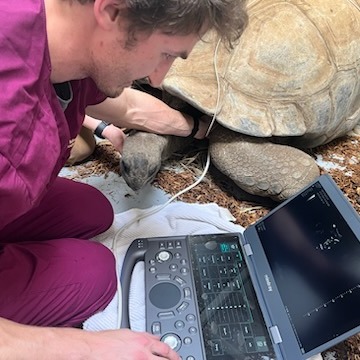- Health challenges and veterinary intervention for Andy the Aldabra Tortoise
- Aldabra tortoises: An overview of their habitat, behavior, and conservation status
- The role of zoos in wildlife conservation and public education
- Advances in veterinary care for large reptiles
- The importance of a natural habitat setting in zoo exhibits for species like the Aldabra tortoise
Andy, the Aldabra Tortoise, is one of the most cherished inhabitants at our zoo. He embodies the majesty of one of the world’s largest tortoise species. With a shell extending nearly 4 feet and tipping the scales at about 500 pounds, Andy’s considerable presence is matched by his age—65 years, a testament to the Aldabra tortoise’s longevity. Yet, despite his impressive stature, Andy has recently encountered a series of health conditions that have called for immediate attention from our dedicated animal care professionals.
When Andy’s caretakers noticed he was coughing more frequently than usual, it raised immediate concern. Coughing in tortoises can be symptomatic of various issues, from minor irritations to more grave conditions affecting respiratory or cardiac function. Recognizing the potential severity of these signs, the zoo staff promptly arranged for an examination by Dr. Anderson, our resident veterinarian. Subsequent tests suggested that Andy’s heart could be the source of the issue, leading to a collaboration with Garden State Veterinary Specialists. This partnership brought expertise from veterinary cardiologist Andrew White, DVM, Diplomate ACVIM, into Andy’s care team.
While his health is monitored and managed off exhibit, Andy’s absence has allowed us to spotlight Patches and Deliah, fellow Aldabra tortoises residing in the new Island Giants section. Guests may miss Andy, but his temporary retreat is essential to facilitate the comprehensive care he requires during this time.
Native to the Aldabra Atoll—a coral island in the Seychelles in the Indian Ocean—Aldabra tortoises are a formidable species adapted to survive in a challenging ecosystem. They’ve evolved to thrive on vegetation available in their habitat, varying from grasses to woody plants. Their status as Vulnerable by the IUCN Red List of Threatened Species underscores the delicate balance these remarkable reptiles maintain within their environment, as they face threats from habitat loss and human activities.
Zoos play a crucial role in wildlife conservation, offering a sanctuary for species like the Aldabra tortoise. Through active participation in conservation efforts, zoos help educate the public on the plights of such creatures while also providing a link between people and the natural world. Moreover, captive breeding programs can help ensure genetic diversity within species and sometimes even reintroduce animals into the wild to bolster dwindling populations.
Advancements in veterinary medicine are invaluable in caring for large reptiles like Andy. The approach to diagnosing and treating reptilian heart conditions, for example, has vastly improved over the years. With the use of sonograms, X-rays, and other diagnostic tools specifically adapted for reptile anatomy, veterinarians can more accurately identify issues and create treatment plans tailored to each individual’s needs. This specialized care greatly improves these incredible animals’ chances of recovery and long-term health.
Another aspect integral to the well-being of Aldabra tortoises in captivity is emulating their natural habitat. The Island Giants section of our zoo was designed to replicate the environmental conditions of Aldabra Atoll as closely as possible. By providing a semblance of their natural home, zoos can stimulate natural behaviors in these animals, which is vital for their physical and mental well-being.
Andy’s scenario illustrates the interplay between all these components: specialized veterinary care informed by advancements in medical technology, the vital role of zoos in conservation and education, and the necessity of a well-constructed habitat to support the health of captive species. Andy, the Aldabra Tortoise, represents the best practices in modern zoological management through the attentive care provided by his caregivers and specialists.
While ensuring that Andy receives the best possible care, our zoo’s commitment to the conservation and well-being of Aldabra tortoises extends beyond our gates. Through collaboration with other conservation organizations and participation in research, we continuously work to protect these magnificent creatures in their natural habitats, contributing to global efforts to sustain biodiversity.
Andy’s story is not just one of a single tortoise facing health challenges. It is a narrative woven with threads of human ingenuity, compassion, and relentless pursuit of knowledge in zoology and conservation. Our gentle giant’s journey stands as a compelling example of how interconnected humans and animals are and how our actions, both within the zoo and in the wider world, profoundly affect the survival and flourishing of species like the Aldabra tortoise.
As Andy’s tale unfolds, his legacy is that of a powerful educator who inspires visitors to learn more about the fascinating creatures sharing our planet and actively participating in their preservation. With the dedicated efforts of caregivers and the public’s continued support, Andy the Aldabra Tortoise will hopefully overcome his current health issues and return to his role as a beloved ambassador for his species, educating and enchanting guests for years to come.
*****
Source Description
🐢 Update on Andy the Aldabra Tortoise 🐢
Andy is our gentle giant with a shell almost 4 feet long and weighing 500lbs! At 65 years old, he’s seen a lot, but recently he’s been facing some health challenges.
A few weeks ago, Andy’s keepers noticed he was coughing frequently, prompting an examination by our veterinarian, Dr. Anderson. Concerns arose about his heart health, leading us to reach out to Garden State Veterinary Specialists and consulting with veterinary cardiologist Andrew White, DVM, Diplomate ACVIM. 🩺❤️ @gsvs_eatontown
Andy is off exhibit being treated for his heart condition for now, but you can visit Patches and Deliah, our other Aldabra tortoises, in the new Island Giants section of the zoo! 🌴 🐢
Aldabra tortoises are native to Aldabra Island, one of the Seychelles northeast of Madagascar in the Indian Ocean, they are classified as Vulnerable on IUCN Red List of Threatened Species.


